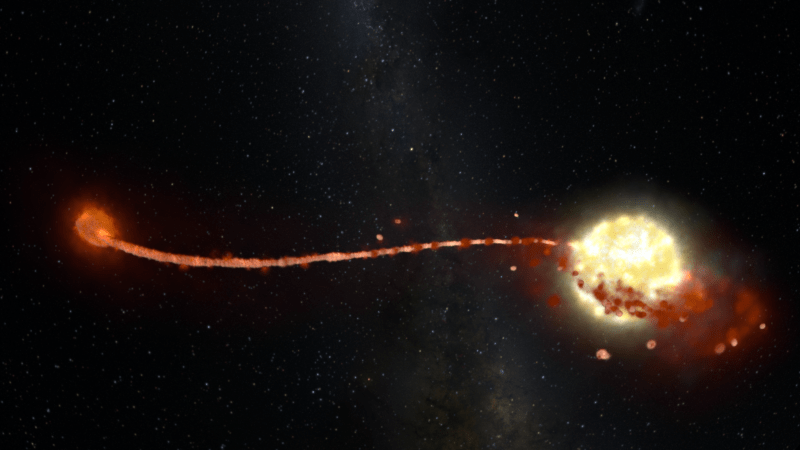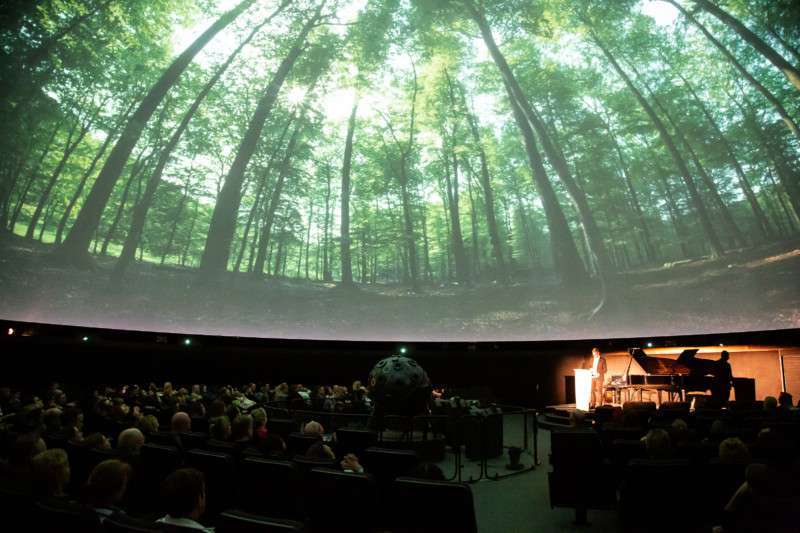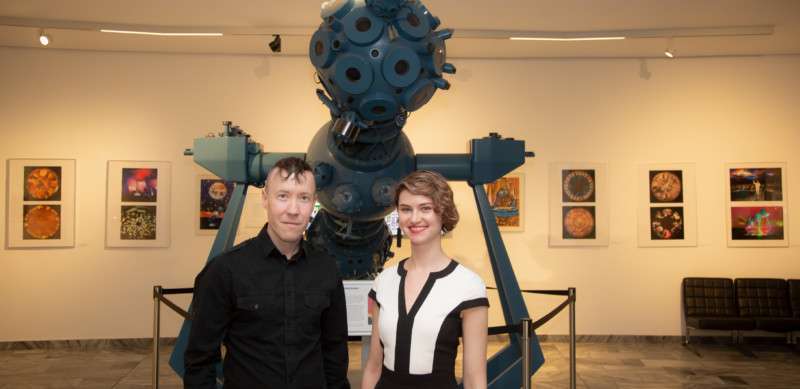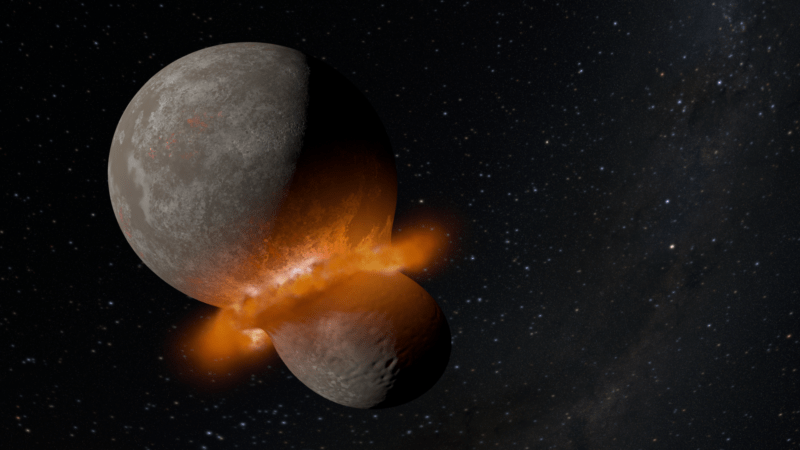New Spitz release “Birth of Planet Earth” explores the celestial events that prepared Earth for supporting life
by Joe Kleiman
ABOVE: Theia slams into the Earth. Earth will soon be enveloped in vaporized rock, some of it hotter than the surface of the sun. Credit: Robin Canup, Southwest Research Institute. Visualization by Advanced Visualization Lab, National Center for Supercomputing Applications, U. of Illinois.
Spitz Creative Media has begun distributing the new show “Birth of Planet Earth” to digital fulldome theaters worldwide. Produced in partnership with the National Center for Supercomputing Applications Advanced Visualization Laboratory (NCSA AVL) and Thomas Lucas Productions, Inc., “Birth of Planet Earth” travels through more than one hundred million years of our planet’s history to explore the origin of life on Earth. The show draws upon the latest scientific ideas, supercomputer computations, and state-of-the-art visuals to give a better understanding of why, in our search of the universe for exoplanets – planets orbiting other stars – we have yet to find one that shares the same size, tilt, orbit, and distance from its sun as the Earth – necessary attributes that all contributed to the evolution of life on our planet.
“Birth of Planet Earth” marks the fourth collaboration between the production partners, following Black Holes: The Other Side of Infinity, Dynamic Earth, and Solar Superstorms. The collaboration had its origins in a PBS/Nova documentary about black holes that producer/director Thomas Lucas was working on with Dr. Donna Cox and her group at the AVL. “Mike Bruno at Spitz persuaded us that the story would really come alive and gain wide exposure in a giant screen fulldome version.”
Visualizing scientific data
Located at the University of Illinois at Urbana-Champaign, the AVL under Cox’s direction is known for taking computational data and redefining it into high-resolution cinematic-quality visuals for public consumption. As Lucas describes it, “The visualization of science through supercomputing resources provides a level of detail and dynamism that’s ideally suited for fulldome presentation.”
According to Cox: “One of the reasons that “Birth of Planet Earth” is unique, is because of the production-quality data visualizations developed by our group. Our AVL team worked iteratively with teams of scientific researchers to transform billions of numbers from computational data into stunning visual scenes for “Birth of Planet Earth.”
Start at the end
As a filmmaker, Lucas always looks for the core idea on which to base the story. In the case of “Birth of Planet Earth”, he found that core in an AVL visualization that he had heard about for years – a flight through primitive bacteria. Once he saw the animation in person, he began to understand its meaning: “The animation of the primitive bacteria shows an energy path of a photon hitting a cell, converting into another form of energy. It was photosynthesis in its most primitive form. Photosynthesis produced oxygen, and oxygen changed the composition of our planet. Life is what turned this planet from a rocky, toxic outpost to Earth as we know it now.”
Lucas would use the advent of photosynthesis as the conclusion to his fulldome show. The lead-up beckons audiences to ask a single question: “Did the Earth have to turn out this way… or was it somehow a fluke?”
Animation problem solvers
Mike Bruno, Media Director for Spitz Creative Media recalls the early days of the collaboration: “We first worked with Donna Cox’s team at NCSA’s Advanced Visualization Lab on ‘Black Holes: the Other Side of Infinity,’ the 2006 Denver Museum of Nature & Science production. NCSA was contracted to produce the majority of the visuals for this show. Tom Lucas, the writer/ director, hired Spitz to create a special-effects shot of several kayakers plunging into a waterfall, as an analogy for falling into a black hole. In the process, we all got to know each other and later (2012) co-produced ‘Dynamic Earth: Exploring Earth’s Climate Engine.’ It has been booked in around 200 domes and translated into numerous languages.”
For “Birth of Planet Earth,” animation duties were split between Spitz and the AVL. “The Spitz Creative team,” says Lucas, “is steeped in visual effects and high-end animation production.” Lucas would construct the film as a back-and-forth between Spitz Creative’s dramatic and realistic animations and the simulations of the Advanced Visualization Lab, creating a visual dialogue between the two visualization styles.

The Grand Tack
Utilizing hydrodynamic simulations, which the AVL visualized for the film, Kevin Walsh of the Southwest Research Institute and his collaborators showed that through a concept known as “The Grand Tack” (named after the sailing term for the action a boat takes as it turns its bow into the wind), Jupiter moved toward the inner solar system, disrupting the orbits of the developing inner planets. Jupiter eventually returned to the outer solar system, drawn by the gravity of another developing giant – Saturn. During the Grand Tack, Jupiter’s gravitational pull caused a number of the inner planets to be ejected from the solar system, while others collided and broke apart. These effects reduced the mass of the inner solar system, ensuring that smaller planets would survive and dominate.
The collision with Theia
Millions of years later, two surviving planets would cross paths… the young Earth and a neighboring proto-planet known as Theia. As the smaller Theia slammed into the Earth, it would explode into an atmosphere of vaporized rock hotter than the surface of the sun. What debris did not fall back to earth orbited the planet for as much as a century, gradually accumulating onto the Moon. Theia’s remains mixed with Earth and became part of the EarthMoon system.
Dr. Cox of the AVL shares: “Dr. Robin Canup of the Southwest Research Institute computed the astrophysics for this crucial moment in the formation of the earth-moon system. Her numerical model generates numbers that describe the physical dynamism of the collision that formed the moon. The AVL transformed Dr. Canup’s numerical data into a dynamic, stunning visualization of this seminal event.”
According to Dr. Canup, the formulation of oxygen molecules found in moon rocks brought back by the Apollo missions is identical to that found in rocks on Earth. This correlation does not exist with meteorites that have impacted Earth, granting credence to the concept that the Moon and Earth have a shared genesis. The collision also tilted the Earth on its axis at 23.4 degrees, which is responsible for our modern seasonal changes as the Earth revolves around the sun.
Making science accessible
“Birth of Planet Earth” provides audiences with an array of important scientific concepts presented in an easy to understand and enjoyable format. According to Spitz’s Bruno: “We’ve done extensive testing with school groups, teachers and general public audiences in several locations. “Birth of Planet Earth” seems to resonate well with grade 6 and older, though even younger kids love the visuals, especially the Theia-Earth impact sequence.
“Our museum partner is the Tellus Science Museum in Georgia. David Dundee (planetarium director) and his team are producing a teacher guide and STEM curriculum resources. They are terrific collaborators and have tremendous experience with outreach education, and expert at creating materials that help teachers and students maximize their planetarium field trip experience.”

International reach
Narrated by Richard Dormer (Beric Dondarrion on the hit HBO series “Game of Thrones”), the 24-minute show is being distributed internationally in a number of languages. “We are just starting to roll it out and were really delighted to see it premiere in Berlin,” says Bruno. “We have lots of interest and a number of other school and museum bookings here in the U.S. The Eugenides Foundation planetarium in Athens, Greece will open the show in the fall.”
Following its world premiere at Berlin’s Zeiss-Großplanetarium in late March 2019, the planetarium’s Director, Tim Florian Horn, commented: ““Birth of Planet Earth” looks at the very beginning of our planet and the unique requirements that enabled life to evolve. The new program helps us to develop a better understanding of the history of our very own existence on this pale blue dot we call home.”
Lucas sums up the film this way: “One of the big revelations of the search for extra-solar planets is that most solar systems don’t look like ours. There are lots of Neptune size planets, for example, within the inner solar systems. In this modern age of planet hunting, there’s something people don’t necessarily ask. Is our Earth a commonplace planet in a galaxy teeming with life, or is it a rare oasis in a barren universe?” • • •
The Advanced Visualization Lab at NCSA
To communicate science to the public, NCSA’s Advanced Visualization Laboratory (AVL) works in close collaboration with domain scientists to create high-resolution, cinematic, data-driven scientific visualizations for planetariums, museums, IMAX films, and TV documentaries. Currently, AVL is leading a National Science Foundation-supported project to inform the public about computational and data-enabled scientific discovery. This project – called CADENS (The Centrality of Advanced Digitally ENabled Science) – is co-producing ultrahigh-resolution digital documentaries for fulldome theaters and high-definition documentary programs for online and television distribution.
The AVL is led by Dr. Donna Cox, who has received international recognition for founding in 1988 the concept of “Renaissance Teams” of interdisciplinary collaborators to solve challenging problems. The AVL is one such “Renaissance Team,” where each member of the team plays a unique role and contributes a variety of skills to the process, development, and production. Robert Patterson (designer, filmmaker), Stuart Levy (computer scientist , astronomer), AJ Christensen (computer scientist, designer), Kalina Borkiewicz (computer/data scientist) and Jeff Carpenter (multimedia, graphics artist) combine their expertise, which includes advanced graphics and visualization techniques, artistic design, cinematic choreography, multimedia and video production, and data management and render wrangling.
Cox is an internationally acclaimed computer artist, designer, writer, and recognized ground-breaker in the art of scientific visualization. Cox’s work is best known for her pioneering use of data visualization and supercomputing. In February 2017, the IMERSA (Immersive Media Entertainment Research, Science, and Art) international organization awarded Cox with a lifetime achievement award for lasting and positive contributions to the digital dome and big screen community.
Dr. Cox strives for blending scientific accuracy with artistry. She and AVL collaborate with science teams and technologists to create cinematic presentations of scientific data and concepts. Together, they have created and directed a large body of compelling work in the cinematic presentation of scientific numerical data, thrilling millions of people worldwide. AVL’s latest popular production includes the “Solar Superstorms” fulldome documentary narrated by Benedict Cumberbatch (2015). Cox and AVL created the opening and closing shots for “A Beautiful Planet” (2016), an IMAX 3D movie narrated by Jennifer Lawrence. They created a virtual flight through Hubble data that comprised a significant portion of the “Hubble” IMAX 3D film that premiered at Smithsonian’s National Air and Space Museum in March 2010. The film won three Giant Screen Cinema Association Awards for best film, best film for life-long learning, and best cinematography. AVL has created production-quality visualizations and co-produced other successful fulldome shows including “Black Holes: the Other Side of Infinity” and “Dynamic Earth.” •

Spitz, Inc.
A fully owned subsidiary of Evans & Sutherland, Spitz, Inc. is located in Chadds Ford, Pennsylvania, about 45 minutes west of Philadelphia on US Route 1. Its 47,000 square-foot facility is home to over 50 fulltime employees.
The expertise of Spitz’s talented team covers all aspects of dome theater design, implementation, and use, including engineering services, manufacturing, installation and show production through Spitz Creative Media.
As a complete integrator of planetarium and spherical projection theaters, Spitz provides display systems, automation, lighting, audio and design/engineering services. Its architectural services include design, fabrication and installation of some of the most innovative dome structures in the world.
Founded in 1947, Spitz began as a provider of affordable optical planetarium projectors for schools and small educational institutions. Since then, Spitz has grown to become the largest supplier of planetariums and domes. Spitz projection domes are chosen by the most discriminating customers including Disney, Universal Studios, Volkswagen, Griffith Observatory, and Zeiss.
Spitz is the world leader in projection domes, with over 2,000 installations worldwide. Despite enormous growth throughout its 70+ year history, Spitz has continued to maintain its focus on educational products and services. •
Thomas Lucas Productions, Inc.
Thomas Lucas is a New York-area filmmaker whose most recent work includes such fulldome productions as “Supervolcanoes,” “Dynamic Earth,” and “Black Holes: the Other Side of Infinity,” partnering with Spitz Creative Media, Mirage 3D, and the Denver Museum of Nature and Science. He also produced “Solar Superstorms,” collaborating with the National Center for Supercomputing Applications and Spitz Creative Media.
Lucas has produced dozens of national and international science productions in collaboration with PBS, the Science Channel and National Geographic Television. He is a co-founder of Alliant Content, which distributes content to online platforms such as Amazon and PlutoTV. The group has released its own branded global digital network, MagellanTV, available on Roku, Fire TV, Android, iOS, and Comcast, and to be released soon to smart TVs. •






